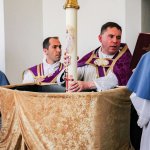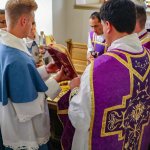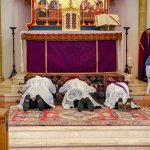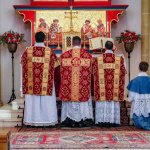Back in 2019, I had the opportunity to attend for the first time the Pre-55 Holy Triduum, and afterwards published an article here about the experience. This year, in 2021, came my first opportunity to assist at the Pre-55 Pentecost Vigil—and, once again, the experience was a triumphant vindication of the wisdom and beauty of tradition. This Vigil is ripe for restoration.
To understand the old Vigil, which reiterates much of the Easter Vigil, one must understand two things: first, its practical origin; second, and more importantly, its underlying theology.
On the practical side of things, the ancient Church baptized catechumens on two major occasions: the Easter Vigil and the Pentecost Vigil. As Dom Guéranger explains in The Liturgical Year:
Formerly, this Vigil was kept like that of Easter. The faithful repaired to the church in the evening, that they might assist at the solemn administration of baptism. During the night, the sacrament of regeneration was conferred upon such catechumens as sickness or absence from home had prevented from receiving it on Easter Night. Those, also, who had then been thought insufficiently tried or instructed and had, during the interval, satisfied the conditions required by the Church, now formed part of the group of aspirants to the new birth of the sacred font. Instead of the twelve Prophecies, which were read, on Easter Night, while the priests were performing over the catechumens the rites preparatory to baptism—six only were now read; at least, such was the usual custom, and it would lead us to suppose that the number of those baptized at Pentecost was less than at Easter. The Paschal candle was again brought forward during this night of grace, in order to impress the newly baptized with respect and love for the Son of God, who became man that he might be the Light of the world. The rites already described and explained for Holy Saturday were repeated on this occasion, and the Sacrifice of the Mass, at which the neophytes assisted, began before the break of day.
However, as the ancient world gradually yielded to the sweet yoke of Christ and Christendom came into being, the number of adult catechumens trickled to little or nothing, and the cleansing of water and the Holy Spirit was administered by the parish priest to the infants under his care (with the fuller outpouring of the Spirit in the sacrament of Confirmation, administered by the bishop, being delayed until children were older). As a result, the Pentecost Vigil ceased to be a liturgy for the conferral of baptisms—but without losing its ancient content.
To see why it is appropriate to maintain this miniature Easter Vigil on the eve of the outpouring of the Holy Ghost, we must grasp the profound connection between the death and resurrection of Christ, the sacrament of baptism, and the gift of the Holy Spirit. “There are three witnesses: the Spirit, the water, and the blood; and these three agree” (1 Jn 5:8). These mysteries are inseparable, so much so that to celebrate baptism is to unite a person to the death and resurrection of Christ; it is to wash away sins and to fill his soul with the grace and charity of God, making it a habitation of the Holy Spirit. Simply put: to baptize is to call down the Holy Spirit, and to celebrate the descent of the Spirit is either to baptize or to recall gratefully one’s baptism into Christ and to seek to deepen it.
Scripture hammers home this point from various angles. In the words of John the Baptist: “I baptize you with water for repentance, but he who is coming after me is mightier than I, whose sandals I am not worthy to carry; he will baptize you with the Holy Spirit and with fire” (Mt 3:11). “When Jesus was baptized, he went up immediately from the water, and behold, the heavens were opened and he saw the Spirit of God descending like a dove, and alighting on him” (Mt 3:16). The Lord said to Nicodemus: “Truly, truly, I say to you, unless one is born of water and the Spirit, he cannot enter the kingdom of God” (Jn 3:5), and later, to His disciples: “John baptized with water, but before many days you shall be baptized with the Holy Spirit” (Acts 1:5). St. Peter commanded the crowds on the day of Pentecost: “Repent, and be baptized every one of you in the name of Jesus Christ for the forgiveness of your sins; and you shall receive the gift of the Holy Spirit” (Acts 2:38). St. Paul bears witness: “For by one Spirit we were all baptized into one body—Jews or Greeks, slaves or free—and all were made to drink of one Spirit” (1 Cor 12:13). The Old Testament prophets were no less explicit. Just take one, Ezekiel: “I will pour upon you clean water, and you shall be cleansed from all your filthiness, and I will cleanse you from all your idols. And I will give you a new heart, and put a new Spirit within you: and I will take away the stony heart out of your flesh, and will give you a heart of flesh; and I will put my Spirit in the midst of you” (Ezek 36:25–26).
What is the purpose of this baptism of Spirit and fire? “Do you not know,” asks St. Paul of the morally wandering Corinthians, “that all of us who have been baptized into Christ Jesus were baptized into his death? We were buried therefore with him by baptism into death, so that as Christ was raised from the dead by the glory of the Father, we too might walk in newness of life. For if we have been united with him in a death like his, we shall certainly be united with him in a resurrection like his” (Rom 6:3–5). “For as many of you as were baptized into Christ have put on Christ” (Gal 3:27).
Once we see this intimate connection between (1) Christ’s death and resurrection, (2) baptism as the fundamental and necessary sacrament of salvation, and (3) the infusion of the Holy Spirit by which we are conformed to the Son, becoming “sons in the Son,” then we see without difficulty why it is fitting for the Pentecost Vigil to echo that of Easter. Indeed, the older English name given to Pentecost, “Whitsunday,” may very well refer to the white garments donned by the baptized.
Between the two Vigils there are shared Prophecies (in other words, all of the second Vigil’s readings are taken from those of the first Vigil’s), the same Tracts sung by the Schola (culminating in the “Sicut cervus” as the procession forms to bring the Paschal candle to the baptismal font), the solemn blessing of the water, and the Litany of the Saints with doubled invocations, leading directly into the Kyrie of the Mass, which features an Epistle followed by an unrepeated Alleluia and Tract building up to the Gospel, after which Mass proceeds as usual. Thus for the symmetry between the inaugural and valedictory Vigils of Paschaltide.
There are, however, many differences, obvious and subtle, between “the mother of all Vigils” and its pentecostal complement that underline the former’s primacy and the latter’s transitional role as the hinge between Pascha and Pentecost. First and most importantly, the Easter Vigil blesses the fire, lights the triple candle, and sings the Exultet before the Paschal candle, while the Pentecost Vigil relies on the already-blessed Paschal candle and commences immediately with the Prophecies.
Second, the Old Testament Prophecies are half in number—six instead of twelve—and those six are read in a different order:
| Easter Vigil | Pentecost Vigil |
| Prophecy I (Gen 1–2:2) Creation account | |
| Prophecy II (Gen 5:32–8:21) Noah and the ark | |
| Prophecy III (Gen 22:1–19) Abraham and Isaac | Prophecy I |
| Prophecy IV (Ex 14–15:1) The Exodus through the Red Sea
Tract: Cantemus Domino |
Prophecy II
Tract: Cantemus Domino |
| Prophecy V (Is 54:17–55:11) The Sending of the Word | |
| Prophecy VI (Bar 3:9–38) The Incarnation of the Law | Prophecy V |
| Prophecy VII (Ezek 17:1–14) Raising of the Dry Bones | Prophecy VI
[Tract: Sicut cervus] |
| Prophecy VIII (Is 4:1–6) The Lord will wash away filth by a spirit of judgment and burning
Tract: Vinea facta est |
Prophecy IV
Tract: Vinea facta est |
| Prophecy IX (Ex 12:1–11) Institution of the Passover | |
| Prophecy X (Jon 3:1–10) The Repentance of Ninevah | |
| Prophecy XI (Deut 31:22–30) Moses on Infidelity of Israel
Tract: Attende caelum |
Prophecy III
Tract: Attende caelum |
| Prophecy XII (Dan 3:1–24) Shadrach, Meshach, and Abednego in the Fiery Furnace
[Tract: Sicut cervus] |
Exploring the rationale of the selection and order of the Pentecost Vigil Prophecies is beyond the scope of this article, but we can see that the longest of the readings have been omitted and the institution of the Passover is not emphasized, while the central baptismal themes are still present: the obedience of faith as exemplified in Abraham; the Exodus as the model of passing from the old life (Egypt = sin and slavery) to a new life (Promised Land = heaven) by way of pilgrimage (desert = asceticism and perseverance); the danger of backsliding, abandoning the law of grace; the promise of a new spirit, a new youth and fecundity, a new life. The tracts sung by the Schola are the same but Attende caelum is sung prior to Vinea facta est, and the Sicut cervus now follows on the valley of the dry bones rather than the fiery furnace.
Third, the orations said after the Prophecies are different from those of the Easter Vigil, and very rich in doctrine and sweet in savor. Consider the remarkable prayers after the second and fourth Prophecies:
O God, who by the light of the New Testament hast expounded the miracles wrought in the first ages of the world, so that the Red Sea was a figure of the sacred font, and the deliverance of the people out of the bondage of Egypt did represent the Christian sacraments: grant that all nations who have now obtained the birthright of Israel by the merit of faith may be born again by the participation of thy Spirit. Through the same Lord…in unity with the same Holy Ghost…
O almighty and eternal God, who by Thy only Son hast shown Thyself the husbandman of Thy Church, mercifully cultivating every branch which bringeth forth fruit in that same Christ, who is the true vine, that it may be more fruitful; let not the thorns of sin prevail against Thy faithful, whom Thou hast transplanted like a vineyard out of Egypt by the baptismal font; but protect them by Thy Holy Spirit, that they may be enriched by everlasting fruits. Through the same Lord…in unity with the same Holy Ghost…
We see in these beautiful orations the tight link between being baptized into Christ and being born again by receiving the Holy Spirit, and the no less tight link between incorporation into Christ, the true vine, and the spiritual fruitfulness of the branch. The loss of such prayers in Pius XII’s severe abridgement of the Vigil is nothing short of tragic.
Pius XII’s slimmed-down 1955 version of the Vigil simply lops off all the Prophecies, Tracts, Orations, Blessing of the Font, and Litany of the Saints, and turns the day into a regular Mass like any other (with minor variations). As one who has now sung at both the post-55 and pre-55 versions of this Vigil, it seems to me that the Pacellian version has an abrupt, pinched, “low-fat” feel to it—not the weight, the density, one would expect of the ceremonies that bring Easter to an end and inaugurate the feast, octave, and season of Pentecost. Think about it: Easter Sunday receives its due preparation by means of the Easter Vigil, the Triduum, and Holy Week as a whole; Christmas too receives its due preparation by means of a Vigil opening on to three distinct Masses, like a bud opening into full flower (Midnight, Dawn, and Day). Pentecost deserves no less amplitude and magnificence.
If Paschaltide is supposed to be like one great feast (as the liturgical reformers parroted, without showing much understanding of what they were saying), then it makes even more sense to close off the period of rejoicing in the Resurrection of Christ by an echo of the great Easter Vigil, like the opening and closing of great doors, before the next “chapter” of salvation history opens upon us in the solemn feast of Pentecost with its octave and the long line of green Sundays numbered according to it. Just as the pre-55 Easter Vigil joins the darkness of Holy Saturday to the full light of Easter Sunday, so the pre-55 Pentecost Vigil profoundly unites the Easter mystery to the outpouring of the Holy Ghost.
Some people ask skeptically: “How far back do you want to go in your efforts at restoration? One century? Two? Five? Ten?” But this is a foolish question. The pre-55 Pentecost Vigil is the form of the rite that was celebrated over at least a millennium, from well before the time of the Council of Trent until the proto-revolutionary pontificate of Pius XII. Pacelli’s version, in contrast, had the inglorious lifespan of about fourteen years before it was bulldozed by Bugnini & Co. in the 1969 missal. The Vigil from 1955 to 1969 is a blip, a speck of dust, in the timespan of Roman Catholic worship (as is the Novus Ordo, which is a slightly larger and more irritating speck of dust). Like the Tridentine inheritance of which it is a part, the traditional Vigil boasts an ancient lineage; it has all the force of immemorial custom on its side. This glorious liturgy just is the Roman Rite’s Pentecost Vigil, and it is time to claim it back. We have the books; we have the know-how; we have the clergy and laity. Tolle, et lege; lege, et ora; ora, et laetare.
A last word—of consolation. Many reading this article may not have access to a Tridentine Mass at all, much less a pre-55 Holy Week, much less a pre-55 Pentecost Vigil. But if this opportunity is not yet available where you live, do not despair. In my own life, I didn’t see a Latin Mass until college, had no regular access till years later, and only in the past few years (after decades of writing about Catholic tradition!) found it possible to move to a city where the TLM is available 365 days a year, along with these great and venerable older rites. It took me till 2019 to see the pre-55 Holy Week, and until this past Saturday to see the pre-55 Pentecost Vigil. The rebuilding on which we are engaged will take time and patience, but it will come, as the inherent superiority of tradition reasserts itself. Get to know the priests in your geographical area, especially younger ones who tend to be more open to tradition, and start floating the idea of a pre-55 Holy Week and a pre-55 Pentecost Vigil for next year. Who knows what the Holy Spirit may inspire in the hearts of the faithful, in the hearts of the clergy? Veni, Sancte Spiritus, reple tuorum corda fidelium, et tui amoris in eis ignem accende.
For those wishing to read more, I can recommend all of the following:
- “The Vigil of Pentecost” (The Saint Lawrence Press)
- “Compendium of the 1955 Holy Week Revisions of Pius XII, Part 7: The Vigil of Pentecost and the Readings from Sacred Scripture in Holy Week” (Gregory DiPippo, New Liturgical Movement)
- “Making Whitsuntide Great Again” (Modern Medievalism)
- “Pentecost Pruned or Restored: The Suppression of the Ancient Baptismal Vigil of Pentecost” (Fr Jean-Pierre Herman, Canticum Salomonis
Photographs by Becca McNally, courtesy of St. Mary’s Oratory, Wausau.









